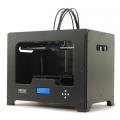Results 41 to 50 of 52
-
01-31-2016, 05:26 AM #41
yeah it's a mistake most people seem to make.
pla is NOT brittle. if you hit it with a hammer it tends to dent not shatter.
What it is, is stiffer than abs. IE: it won't flex as much. But brittle - nah.
You have to bear in mind that in the last 3 years, the market has gone from basic umodified pla to hundreds of different formulations of modified pla - pretty much all of them tougher and better than the original filament.
-
01-31-2016, 07:54 AM #42
-
02-01-2016, 08:34 PM #43Student

- Join Date
- Nov 2015
- Location
- Ontario, Canada
- Posts
- 4
I would try PETG Instead of ABS. PETG does not Shrink, and warps much less then ABS, Doesnt smell, is just as strong. and its Food safe and isnt toxic
-
02-01-2016, 09:59 PM #44
-
02-02-2016, 01:51 PM #45
If you use this filament - then yes you CAN make food safe objects.
http://3dprintingindustry.com/2015/0...t-kills-germs/
Also like everything else if you clean your stuff properly, it's not an issue. These days I mostly use 3d printed stuffer nozzles for making sausage. And nobody has died :-)
Reason being the standard nozzles are too big to fit inside a tube of collagen casing without unravelling it. The ones i made work brilliantly.
The other thing to bear in mind is that most modern washing up detergent is also antibacterial. Scrub in hot antibacterial water and it's absolutely fine.
But - as always - if you don't clean your stuff properly and die of food poisoning, it's not my fault and sebastien told you so ;-)
Actually the other stuff you can use is any filament that has copper in it. Copper is one of the best natural; antibacterial and antiviral substances on the planet.
And while not marketed as such, the reprapper pla with copper probably kills more bugs than the purement stuff and it also comes in bendy. But it ain't official - so as always if you die, it's not my fault.Last edited by curious aardvark; 02-02-2016 at 02:04 PM.
-
02-02-2016, 02:07 PM #46
-
02-02-2016, 02:08 PM #47
-
02-02-2016, 02:46 PM #48
lol they don't call me the procrastination king for nothing :-)
If it wasn't for the internet I'd have time to do all the stuff I'm supposed to be doing :-)
Still this forum is technically work related, so that's okay then lol
-
04-26-2016, 11:13 AM #49Student

- Join Date
- Apr 2016
- Posts
- 6
The problem is that it's almost impossible to answer the PLA/ABS question just by looking at the material characteristics as it is so dependent on the application and even the specific object you're printing.
The decision guide in this infographic covers several key points that usually should be involved when deciding between ABS and PLA:
Ventilation - I wouldn't recommend putting your nose into the printer with any material, but being exposed to ABS fumes is likely a lot worse.
Heated Bed - This is an easy one: Without one, PLA should be your choice.
Exposure to Heat or Mechanical Stress - ABS would be the preferred choice as PLA melts at lower temperatures (it might start to deform when left in your car in the summer) and ABS can endure more bend before breaking.
Of course even ABS has upper limits and you might want to consider other materials like Polycarbonate for extreme applications.
On the other hand there are newer materials that share many PLA features (biodegradable, no heat bed required) but are more similar to ABS in their mechanical properties (e.g. BioFila Linen) and temperature stability (e.g. Advanced PLA, ExcelFil EVO).
Printer Enclosure - Not a must-have for using ABS, but especially objects with large footprints are susceptible to warping when they cool to fast. A fully enclosed printer ensures a slow and even cooling process.
Post Processing - Often an afterthought, but ABS has a slight advantage here as it is a little easier to sand and you have the option of working with acetone (which I personally wouldn't mess with unless you REALLY need to).Last edited by FilamentGuy; 04-27-2016 at 12:08 PM. Reason: adding content summary of referenced website to avoid link rot
-
04-26-2016, 11:37 AM #50
I used abs for about 6 months - in fact some the the stuffer tubes are made of the stuff.
For the last 2 years I've just used pla - for everything.
And I don't feel I've lost out in anyway.
A lot is down to how you design the object and the rest is down to how you slice it.
Unless you want a living hinge in a fairly stiff filament - in which case you probably want polycarbonate, pet or nylon - I can't think of anything where pla isn't at least as good as abs.





 Reply With Quote
Reply With Quote








Ender 3 Neo - Jam Problem
Yesterday, 03:06 PM in Tips, Tricks and Tech Help